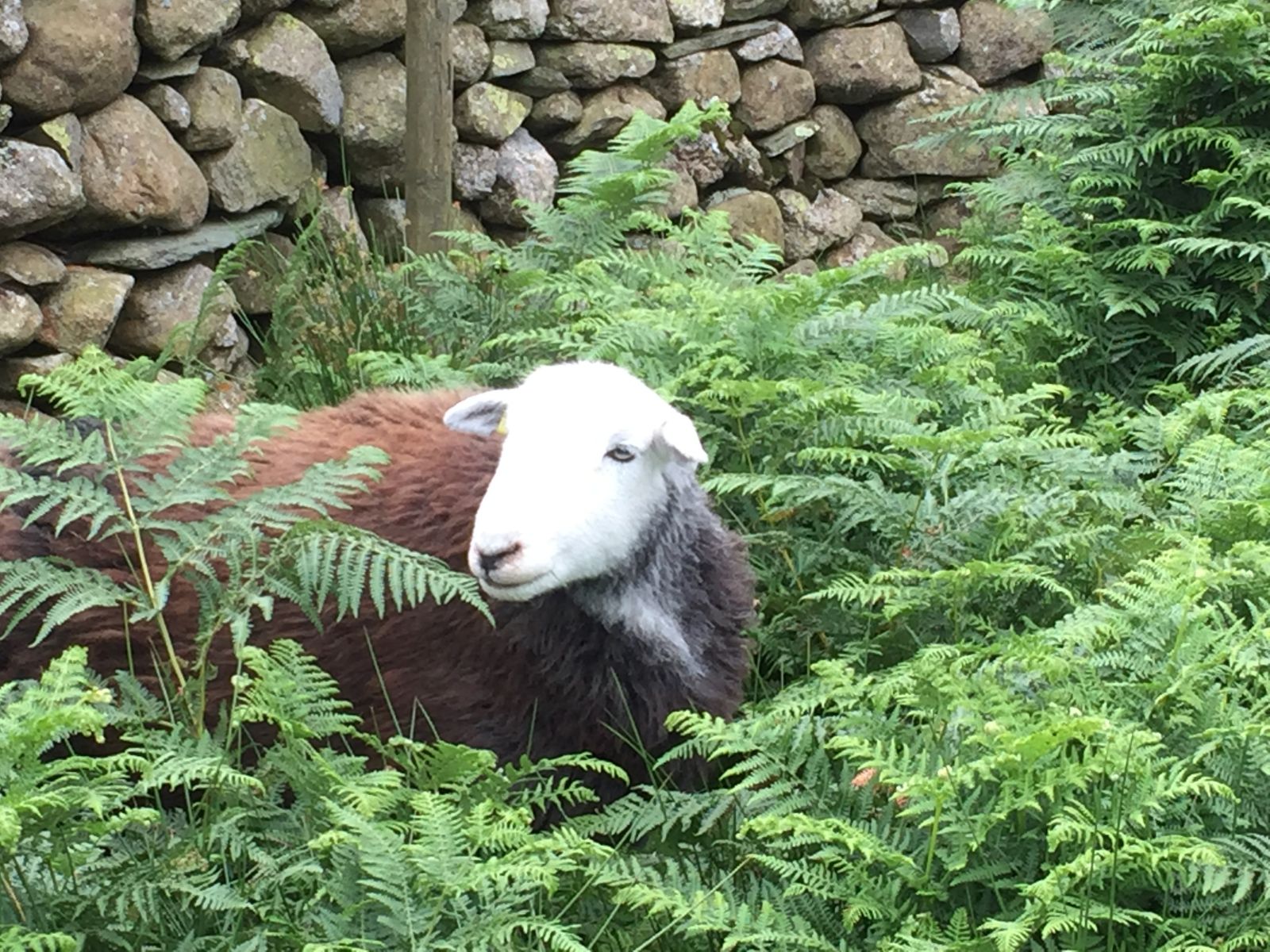THE 3 MOST COMMON TREATMENTS FOR RAILWAY SLEEPERS
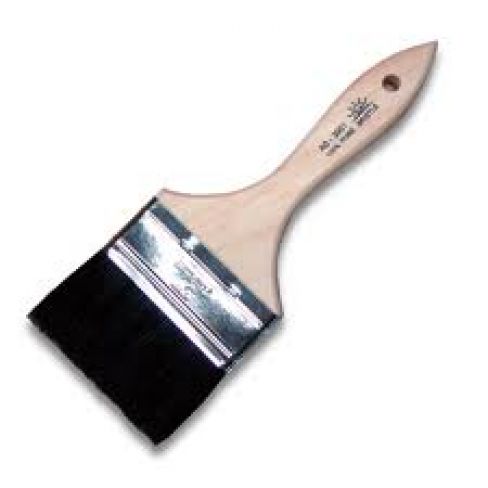
1) CREOSOTE TREATMENT - used for over 150 years to lengthen life of railway sleepers, but now facing some restrictions.
SEE BELOW
2) 'GREEN' PRESSURE TREATMENT - the latest 'environmentally friendly' pressure treatment for railway sleepers. SEE BELOW
3) UNTREATED - some tropical hardwood railway sleepers are naturally long lasting, durable & hence need no treatment.
SEE BELOW.
USED RAILWAY SLEEPERS are normally either
a) Creosote treated, e.g. used Dutch Oak and used British pine, or
b) Untreated, e.g. used Australian Jarrah and used African Azobe railway sleepers. Even though a used railway sleeper is untreated there can occasionally be deposits of oil or diesel on the surface which have fallen from passing trains over the years (not to mention other things!)
NEW RAILWAY SLEEPERS are normally either
a) Green treated e.g. new British softwood railway sleepers. These are environmentally friendly non-creosote based preservatives, with treatment names such as ACQ, Tanalith E, Osmose or Wolmanit, all of which are suitable for landscaping projects, or
b) Untreated, e.g. new oak sleepers
1a) CREOSOTE TREATMENT - Is it safe? - THE FACTS - THE ONE MINUTE VERSION !
1 MINUTE VERSION ... for those in a hurry to get into their gardens !
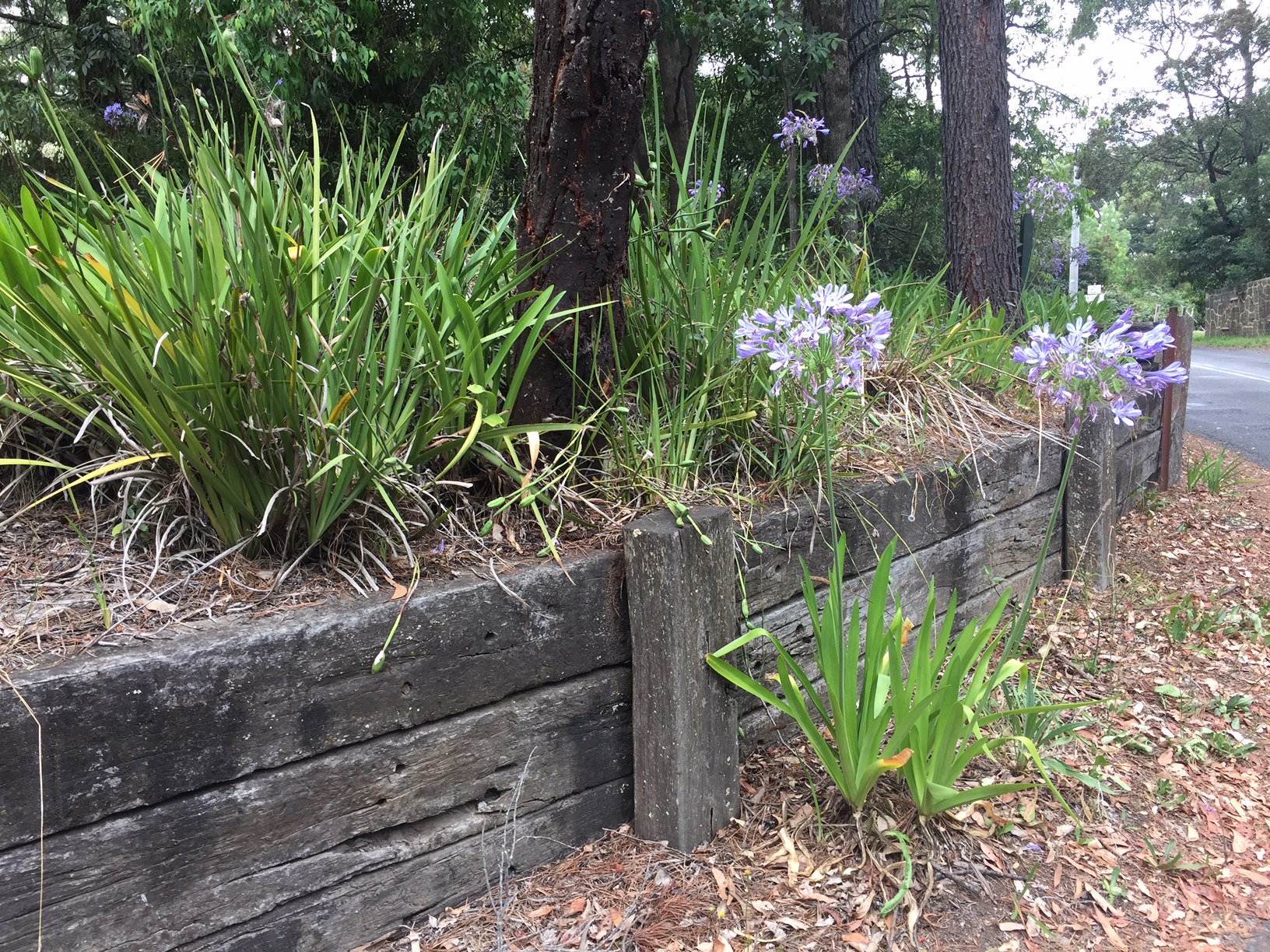
a) should NOT be used where there is a risk of frequent skin contact, (e.g. schools, play areas, benches etc..)
b) should NOT be used where they may come into contact with food stuffs, (e.g. picnic tables)
c) should NOT be used inside buildings. (e.g. fireplaces and lintels)
So, to sum up, for all you speedy gardeners:
- Don't use creosoted railway sleepers around children, food, or put them indoors.
- Don't put them in places where people may sit on them or regularly come into skin contact with them.
- Always handle with Gloves, and wear a dust mask when cutting.
So there you have it ... Get out there and plant! And if you're still unsure, read below! Incidently, the picture below is John Cleese serving Mr. Creosote, in the Monty Python film, 'The meaning of life'. The shot is taken seconds before the inevitable revolting stomach explosion.
RailwaySleepers.com is registered by the environment agency for importing and selling railway sleepers
1b) CREOSOTE TREATMENT - Is it safe? - THE FACTS - THE LENGTHIER VERSION !
THE LONGER VERSION ... for those with time to make up their own mind !
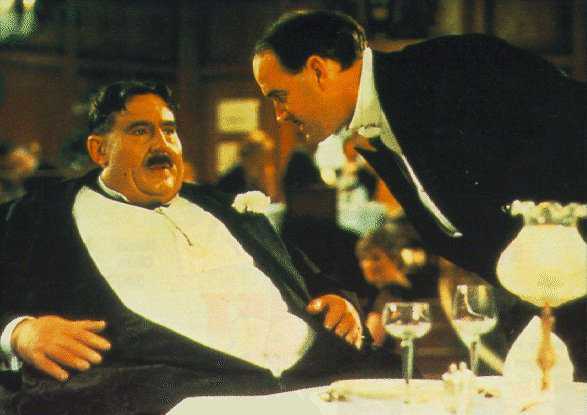 We have included everything to make you snooze in your armchair, including old newspaper scare stories, research findings, European law and even possible answers to:
We have included everything to make you snooze in your armchair, including old newspaper scare stories, research findings, European law and even possible answers to:
Are creosoted railway sleepers safe ?
Will creosoted railway sleepers be banned ?
Can you use creosoted railway sleepers in a vegetable bed ?
The meaning of life?
RECENT STUDIES
Creosote has been used for over 150 years to preserve and increase the life-span of railway sleepers. Scientists recently discovered that the previously safe level of 50 parts per million of benzopyrene in creosote was now unsafe, which led on to EEC restrictions regarding the use of 'new creosote', and to a lesser extent 'used creosoted materials'. An EU directive sought to protect the public from benzopyrene found in creosote which, according to one German study, is now more harmful than previously thought. Benzopyrene is a carcinogen found in coal tar derivatives like creosote, as well as in cigarettes, and hamburgers cooked on charcoal-fired barbecues. A commission press release stated ....'The European Commission today adopted a new Directive banning the sale to consumers of the wood preservative creosote, after an EU scientific committee concluded from a recent study that creosote has a greater potential to cause cancer than previously thought, and exceeds the limits permissible under existing legislation. The ban, which takes effect from 30 June 2003 at the latest, also applies to creosote-treated wood. Creosote may still be used for industrial applications, e.g. railway sleepers and telegraph poles, but with tougher restrictions on its composition.' Enterprise Europe, Brussels, 26 October 2001 IP/01/1500
NEWSPAPER SENSATION ! READ ALL ABOUT IT !
 This press release was sensationally yet inaccurately picked up in the Daily Telegraph in February 2003:
This press release was sensationally yet inaccurately picked up in the Daily Telegraph in February 2003:
'Toxic sleepers hit the buffers'
'They're useful, decorative and soon to be illegal....'
By Giles Chapman (Filed: 15/02/2003)
Old railway sleepers, those sturdy slabs of timber with 1,000 horticultural uses, have never been so plentiful to gardeners. Whether for building a raised bed, boxing in a compost heap or creating rustic-looking paths, they're unbeatable. And they're also great value: Sheila Johnson, manager of Central Wool Growers, a farmers' co-operative in Market Rasen, Lincolnshire, sells railway sleepers at £20.56 each. "We're asked for them constantly," she says. But the days of the trusty sleeper are almost over. After June this year, you will no longer be able to buy them. (UNTRUE!)
You'll probably groan when you hear the European Commission in Brussels is to blame, but the reason seems earnest enough. An EU scientific committee concluded from a recent study that creosote, in which all railway sleepers are liberally lathered to stop them rotting, is more dangerous than previously thought. Creosote is a chemical cocktail obtained by distilling coal tar and is classified as carcinogenic because the mixture contains benzopyrene (BaP). Scientists used to think that as long as there were no more than 50 parts of BaP per million in creosote, it was harmless. Now they've concluded that even such a tiny amount can cause cancer in humans. So from June 30 the sale of creosote and creosote-treated wood will be banned. (UNTRUE!)
Clearly, creosote is finished. But what about railway sleepers? Sylvia Wiltshire wishes she knew. She's been running the Nottingham Sleeper Company for 38 years. "I just can't get any answers," she says. "We don't really know what's going to happen." Her office looks out on a seven-acre yard bursting with old railway sleepers. At times, there are 30,000 in stock and she sells 2,000 a week, mostly to garden centres. Mrs Wiltshire says there are several similar suppliers in the UK. "We also uplift them and take them away," she adds, hinting at the massive logistical nightmare for Network Rail if 150,000 old railway sleepers can't find a home. She also doubts old railway sleepers are harmful. "Most of them are so weathered they've lost most of the treatment," she says. "These things aren't waste: every railway sleeper can be re-used and recycled. That has to be better than cutting down more rainforests."
Railway sleeper enthusiasts, if you can call them that, are also incensed at the EU directive. Charles Kenyon, who lives near Lincoln, has bought dozens and used them them for creating raised beds in his herb garden, for making gateposts and building sheds. "They're excellent things," he says. "In some cases they have matured over hundreds of years. "Ecologically, re-using old railway sleepers is the best thing that can possibly be done with them, despite a drop of creosote." End of the line Network Rail replaces one million railway sleepers a year, although less than half are now wooden. They're replaced by concrete and solid steel sleepers from the US. Most reclaimed railway sleepers are pine, with one in 10 made from hardwoods such as oak and even mahogany. After June 2003, Network Rail will store treated railway sleepers until it works out what to do with them. One option is to chip and burn them as fuel. This requires specially designed plants. Although these exist in Scandinavia and Germany, as yet there are none in Britain.
© Copyright of Telegraph Group Limited 2003. Terms & Conditions of reading. Commercial information. Privacy Policy.
CONFUSION REIGNS !
This article added to the already confused position of those who were buying and supplying railway sleepers. Would they be banned ? Could they still be sold after June 30th 2003?
We wrote in February 2003:
"Showing a confusion and a distinct lack of communication is the present situation concerning creosote treated railway sleepers... Network Rail is supposedly not releasing any used British railway sleepers that they take up from the track, after June 30th. They will be stored somewhere and eventually disposed of, through whatever means. June 30th is meant to be the actual ban day in this country, according to the European parliament, for creosote treated railway sleepers. However there's masses of uncertainty. What about untreated railway sleepers, like Australian Jarra and African Azobe ? What about imported, graded, creosote treated railway sleepers that are designated for landscape or construction use? Lots of uncertainties... and most people in the business are scratching their heads with incredulity. Will there be midnight raids of railway sleeper depots, or shady blackmarket deals with railway sleepers being exchanged on isolated waste grounds for cash in brown envelopes? Will there be a railway sleeper mafia with turf wars on old railway sidings? Dramas such as Narcos, Ozark and Queen of the South will pale into insignificance as the new Railway Sleeper King overtakes the reputation of Pablo Escobar. Who knows?!!"
Things gradually became clearer. The Directive, which was published for consultation by the DTI (closing date 2 Feb 2003), had an exemption for reclaimed railway sleepers and other creosote-laden wood which said:
3.9 Wood treated with the substances listed in Directive 2001/90/EC.
'The prohibition . . . on placing on the market, does not apply where wood so treated is placed on the second hand market for re-use. Uses for which wood referred to . . . may not be used: - inside buildings, whatever their purpose - in toys - in playgrounds - in parks, gardens, and outdoor recreational leisure facilities where there is a risk of frequent skin contact - in the manufacture of garden furniture such as picnic tables, - for the manufacture and use and any re-treatment of containers intended for growing purposes, packaging that may come into contact with raw materials, intermediate or finished products destined for human and/or animal consumption - other materials which may contaminate the products mentioned above.'
We wrote again in May 03 :
"Railway sleepers WILL still be released for sale by Network Rail and also WILL still be imported into this country after June 30th, so rumours of empty supermarket shelves are false. Clearly creosote treated railway sleepers should now not be sold to schools, play areas and public places, where there might be 'frequent skin contact with creosote' but at the same time it is green light as usual for professional and industrial uses, which include: agricultural, railway, forestry, fencing, harbours and waterways and electric power transmission and telecommunications. Governmental advice to RailwaySleepers.com recently acknowledged that private use of railway sleepers in private gardens was still acceptable".
FROM THE HORSES MOUTH!
If you want to read the original DTI paper, visit www.dti.gov.uk/ccp/consultpdf/creosote.htm
RUMOURS
Rumour has it that a UK study shows that where creosote impregnated railway sleepers are in contact with the soil, an organism that thrives on benzopyrene neutralises the creosote over time. If this is the case clearly reuse along traditional lines is the best thing that could happen to an old railway sleeper
QUESTIONS & ANSWERS GIVEN BY THE DEPARTMENT OF TRADE AND INDUSTRY
Q1. Creosote is a well tried and tested popular brand; I have been using it for years to paint my garden fence and furniture, why has it suddenly become a case for concern?
Recent studies by the Fraunhofer Institute of Toxicity and Aerosol Research (Hanover, Germany) found that creosote had a greater potential to cause cancer than had been previously thought. The study was referred to the European Scientific Committee on Toxicity, Ecotoxicity and the Environment (CSTEE), an advisory body to the European Commission, who concluded that there is a cancer risk to consumers from creosote. The Committee considered that the magnitude of this risk gave clear reasons for concern. In the light of those concerns, Directive 2001/90/EC was adopted by the European Council on 26 October 2001 and must be implemented by all Member States. The legislation came into force in the UK on 30 June 2003.
Q2. Are there alternatives that I could use?
The main use of creosote is as a wood preservative. There is a range of other products on the market with varying colour, which can perform a similar function.
Q3. I am a member of a railway restoration association, which makes use of railway sleepers, is it now the case that we will no longer be able to use creosote- treated railway sleepers?
No, it is not the case that you will not be able to use creosote-treated railway sleepers. Old railway sleepers treated with creosote prior to the 30 June 2003 can still be used for railway restoration purposes. They can also be placed on the market for second-hand re-use, but only for the purposes outlined in the Regulations. You will also be able to buy new railway sleepers for use on a railway. After the 30 June 2003, creosote can be sold and used in industrial installations and by professionals providing that the creosote complies with the new compositional requirements and the restrictions on the uses of wood so treated. Examples of permitted use include telegraph poles, railway sleepers, fencing and certain agricultural purposes.
Q4. After 30 June 2003 will I be able to purchase and use old railway sleepers?
Yes. But only for the purposes outlined in the regulations. Old railway sleepers treated with creosote can be used in parks, gardens, and outdoor recreational and leisure facilities but only if there is no risk of frequent skin contact. However, old railway sleepers treated with creosote must not be used inside buildings, whatever their purposes; in toys; in playgrounds and for garden furniture such as picnic tables.
Q5. My raised garden bed consists of creosote-treated railway sleepers. Should I be digging these up?
No. Wood treated with creosote prior to the coming into force date of the Creosote Directive, may be used in gardens, providing there is no risk of frequent skin contact. Furthermore, the prohibition on the use of treated wood does not apply where the treated wood was in such use before 30 June 2003, the date these Regulations came into force.
Q6. What is meant by frequent skin contact?
Frequent could be defined as “happening or occurring often or at short intervals”. In the context of the creosote directive, frequent skin contact could be considered as repeated (habitual) contact of the skin with, for example, creosote-treated railway sleepers. Habitual practices such as constant sitting, leaning against, laying on, walking on creosote-treated wood could be considered as frequent skin contact if there is no barrier between the skin and the treated wood. A person constantly handling creosote treated wood, especially without gloves, as part of their job (daily routine) could be said to be making frequent skin contact with creosote.
Q7. What shall I do with the couple of tins or so of creosote I have stashed away in my garden shed? Can I pour them down the drain?
No, you must not pour creosote down the drain. Contact your local authority and/or the Environmental Agency on how to dispose chemicals of concern. Many local authorities waste disposal sites have special arrangements for disposing chemicals.
YOUR COMMON QUESTIONS & A FEW MORE ANSWERS!
CAN YOU REMOVE MUCK OFF RAILWAY SLEEPERS?
We have got railway sleepers that we want to make into decking however they are covered in years of railway muck - is there a product we can use to clean this mixture of oil and muck off? Do you sell it etc?
Railwaysleepers.com: Cleaning up sleepers depends on what's on them. If 'railway muck' is merely airbourne grime and dust, then scrubbing with soapy water & detergent / or wirebrushing / or power jetwashing should nicely do the job. If it's some surface diesel / oil that has dripped down from an engine, then detergent or an oil 'dissolver' will deal with it. If you're talking about internal tar and creosote from the original treatment of the timber, then there's virtually nothing you can do, especially if it's continuing to ooze from within. Hot weather tends to draw the creosote and tar to the surface, where it fluctuates between being hard or sticky in various temperatures. Not nice or recommended for decking, especially with creosote treated British pine railway sleepers.
CLEANING OFF OOZING TAR?
I have had my garden landscaped and used old railway sleepers around the perimeter and for seating. Whenever it is warm and sunny some of the sleepers ooze tar. My young children keep getting covered in the oily mess much to the disdain of my wife. I have tried a high pressure jet hose on the railway sleepers but this has had no effect. Can you help?
Railwaysleepers.com: Unfortunately your story is all too familiar. There are only three effective options, I'm afraid.
1) If the oozy tar is unacceptable, (very understandable), remove the railway sleepers. There's nothing effective you can do to stop them leaking.
2) Replace them with non-creosote treated railway sleepers, whether new or used. Landscapers should not really be using the old GB pine sleepers, due to their unpleasant leaking. The best used railway sleeper would be the African Azobe or Jarrah railway sleeper that is an untreated (and needs no treatment) tropical hardwood, that is very dense, and is sometimes used underwater, or for lock gates etc.. Alternatively new pressure treated Baltic / Scottish pine (treated with an environmentally child friendly treatment) or new untreated French oak. We can help you choose if you need.
3) Clad the existing railway sleepers with some kind of timber, decking or material that covers up the tar
WEEPING CREOSOTE
I currently have about 15 railway sleepers (Used British Pine) for a long row of 5 steps leading from the patio onto the grass. Trouble is, I keep getting tar weeping from some of them, and over the past couple of weeks it just got worse and worse. I was wondering if you knew of anything I could use to stop the tar from weeping; I would like to keep the ‘’used’ look, but would personally be happy for a quick fix which I could do until I re-arrange the garden and order something without tar or creosote.2
Railwaysleepers.com: See above. This type of question is the one we receive most. (several times a week).
GARDEN CENTRE ERROR
Our local garden centre staff told me they didn't supply used railway sleepers anymore as they were not allowed to due to the oil thats soaked in to them.
Railwaysleepers.com: Tell them to get their facts right !
ILLEGAL?
Could you help me. I am told that it is illegal to use railway sleepers in the garden (because of Europe.. so I am minded not to comply) but I need 10 to terrace my garden. Adrian Andrew
Railwaysleepers.com: Fear not, the knock on the door by the special branch is unlikely to follow your use of creosoted railway sleepers in the garden ! They haven't been banned, only restricted. 1) you can't eat off them 2) you can't use them for children's play areas (or areas of frequent skin contact) 3) You can't use them inside a house. So, you should have no problem using them as a terrace.
SAFE FOR FURNITURE?
Hi, We are are a small furniture design studio in Israel. We use old railway sleepers to build some of our home and garden furniture. Some railway sleepers are used whole and some are cut in different ways. Lately we heard about the dangerous CREOSOTE used as pesticides. We are both exposed to saw and sanding dust in the workplace and are concerned about the possible hazard to our customers. We saw your web site and are hopeful that you can advice us on some matters What procations are you taking while handeling, cuting and sanding the railway sleepers? Do you know if coating the wood with varnish makes it safe to be used as a furniture? Dose the strong odor coming from some railway sleepers indicates the level of toxicity? Is using dust musk while cutting and sanding the Is it O.K. to put these furniture in the house or only outdoors? We have no access to reliable information in Israel and will be very happy if you can help us. You are also welcome to visit our site www.nimrodeilam.co.il (the railway sleepers furniture are presented only in the Hebrew part) Thank you for taking the time to read our mail
Yours Sincerely Harel Nadav
Railwaysleepers.com: Thankyou for your e-mail, and quite excellent pictures. We will put them on our website, as examples of your studio's work. We have visited your great site and find your design and creativity very impressive. Both simple and stylish.
It's hard to answer accurately your questions. Firstly because we are not doctors or scientists, and secondly because there is not much written about the effects of creosote. So please don't take our opinions as hard evidence !
1) Creosote has been happily used for hundreds of years. It is only in the last three months in Europe, that there has been restrictions on the use of railway sleepers that have been creosote treated. (see our article on 'Railway Sleeper treatments')
2) The European restrictions say that creosoted railway sleepers should not be used where there may be 'frequent skin contact', risk of 'food contamination', or 'inside houses'. However they can still be used for many landscaping, construction etc.. purposes.
3) In terms of ourselves, we use gloves when handling railway sleepers, and are wary of inhalation of sawdust whilst cutting, as one would be with any type of timber. We only cut them outside. We don't sand them, although customers do do this, as well as sand blasting them, and pressure washing them. I don't know whether the stronger the smell indicates that a railway sleeper is more 'dangerous'. However, it is true that older railway sleepers tend to smell less, as though the creosote has weakened or evaporated.
4) Should you use creosoted railway sleepers as furniture ? Fortunately, or unfortunately the decision has already made for us by the European Parliament. We're not allowed to use creosoted railway sleepers as furniture. However, we have in the past quite happily used them inside houses. The issue then was merely whether there was surface tar, oil or creosote to make it impractical or unpleasant to use as a seat (for example), or whether the smell was too nasty to have inside. The conclusion is that you can make furniture out of used railway sleepers that are untreated (e.g. Jarrah, Azobe, Oak etc..) or treated in an uncreosoted way (e.g. eco friendly green tannalised pine) or use new untreated railway sleepers.
5) I don't know whether varnishing the surface of the railway sleeper would 'seal' the creosote inside. I doubt it.
FURNITURE RIP-OFF?
Hello, I have seen many purveyors of furniture made from railway sleepers, specifically coffee tables. I'd very much like to own one, but am a little reluctant to pay the sometimes astronomical prices asked for such items. I therefore had the idea that i would buy my own railway sleepers (from a reclamation yard) and create my own furniture. I then read on your site that the original treatment of such timbers make most of the old oak railway sleepers unsuitable for such a use. Can you advise me if there are any railway sleepers that may be suitable for my requirements? Do I need to do something with the timbers that make them suitable for indoor use and is this why furniture companies charge so much for their stock? Thanks in advance. Marc
Railwaysleepers.com: It's a big rip-off world out there... so what's new ! There's lots of railway sleepers, new and old, that might be suitable. New are more straightforward because they are straighter, and not treated with anything nasty - so, NEW British Pine or French oak. Used would mean Australian Jarrah (untreated) or African Azobe (untreated). Best thing is to come and chose and take them away with you.
STICKY SITUATION?
Hi, I'm wondering if you can help us. we've just had our garden landscaped and have 2 large flights of steps made from old railway sleepers which have already started leaking tar in the recent warm weather - no one warned us that this would happen. the contractor has merely told us to throw sand over the tar but this doesn't stop it getting on your shoes etc. is there a product that will seal them or do you have any tips which you would be willing to share with us? Many thanks,
Sue Thomas
Railwaysleepers.com: Sorry to hear your news - the last thing you want in your new landscaped garden. There's no magical solution I'm afraid. Used softwood railway sleepers (British pine) treated with tar and creosote, will invariably leak in hot weather. We've stopped recommending them for family and public landscaping in the last few years for that very reason. There are much more preferable railway sleepers that are untreated, or treated with different solutions that have no tar or creosote base, that would be perfect for you. So saying, I appreciate that this is absolutely no comfort to you at all. My advice is to (a) grin and bear it (b) replace them with similar size and profile railway sleepers, but in a nicer tar-free or untreated version (c) I can't think of any others. As a gesture, we will supply the right size to you, as economically as possible. Alternatively, invite the well heeled contractor to sit on your steps for a quiet sticky chat.
SAFE TO USE IN MY VEG BEDS?
I’m not sure if you’ll be able to help me, but I have a question about railway sleepers. I have several of them that I was planning to use as the border for my vegetable garden. They are old but I’m not sure what type of timber they are or how they were treated. After we put them in place I came across some information that they may not be safe to use for the garden, so we left them there with the plan to learn more about it. They have been sitting there for about a year now, and I’m just concerned they may have damaged the soil. So my question is, a) are they safe to use and, b) Could they have caused damage to the underlying soil?
Sarah
RailwaySleepers.com: There are only safety issues to consider IF your railway sleepers are definitely creosote treated. Unsure? The answer to that question is often in what the railway sleepers are made of. If they are British or European pine, or alternatively European Oak or Beech, then they are almost definitely creosote treated. During warm weather the railway sleepers will probably smell of creosote, tar or diesel or have droplets of black stickness on the surface. You are welcome to send us photos of the railway sleepers if you have problems identifying them.
IF YOU KNOW that the railway sleepers have been creoste treated:
Don't use the railway sleepers where people may have frequent skin contact with them, e.g. with children around a play area or sandpit. Don't put them in places where people may sit on them.
Don't use them around food, e.g. as a picnic table or kitchen surface.
Don't use them indoors, e.g. as a lintel or fireplace.
Always handle with gloves, and wear a dust mask when cutting.
It is very unlikely that using your railway sleepers as a border around your vegetable patch will damage or contaminate the soil, and so should be fine for growing veg. The main issue is avoiding any oily creosote getting on your clothes when you kneel down to pick your bumper crop of courgettes and tomatoes!
Thanks to Jeff Howell's opinion on USING railway sleepers INDOORS
Thanks to Jeff Howell from The Telegraph, who replied to a readers question by saying that second-hand railway sleepers impregnated with creosote should not be used for building work inside the home:
Question: Our house has a railway sleeper above a DIY fireplace. While having some changes made recently, I realised the railway sleeper has been creosoted. We installed a wood-burning stove about three years ago. Could the heat from this release creosote fumes? And could this explain the problems I have had during the winter, with sore eyes and nose? At first I thought this was due to dry air, but can you tell me of any health implications from creosote fumes? JE, by email
Answer: Creosote is a most effective wood preservative, which is why timber railway sleepers were impregnated with it. Second-hand railway sleepers are useful for garden work, such as raised beds and terracing, but they do tend to seep creosote, and are therefore not suitable as benches or steps. And they should certainly not be used for building work inside the home.
Apart from the fact that the smell will linger forever, creosote is a suspected carcinogen through repeated skin contact in its wet state, which is why it is no longer sold in small quantities for DIY use. I do not think you need worry about this aspect, but you should certainly be concerned about the fumes given off when the railway sleeper is heated by your wood-burning stove. These vapours are a well-known cause of irritation to the eyes and respiratory tract, and you should take immediate steps to have the railway sleeper removed. You could either use a concrete lintel above the fireplace opening or, if you want to keep the timber look, then a local timber merchant will cut you a nice thick section of larch, which will smell only of resin.
(PS You could also try new oak, or an untreated tropical hardwood railway sleeper like Jarrah or Azobe)
SOMETIMES OUR TONGUE IN CHEEK APPROACH GETS US INTO TROUBLE !
We once wrote a flippant piece, when everyone was worried about creosote, entitled:
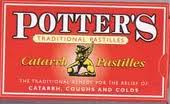 I SUCK CREOSOTE - 20 times a day! .....WORLD EXCLUSIVE !!
I SUCK CREOSOTE - 20 times a day! .....WORLD EXCLUSIVE !!
Blocked up by a slight cold last year, as summer slipped into damp autumn, and Nottingham Forest's early sparkling form duly subsided into mediocrity, I invested in some Potter's traditional pastilles (£1.85p) 'The traditional remedy for the relief of Catarrh, Coughs and Colds' (and ailing football teams).
Clearly unpeturbed by the mighty European Parliament and Dept. Trade & Industry's rulings that creosoted materials should not be touched, placed indoors, or allowed to contaminate foodstuffs, this invigorating and brave lozenge declares in it's ingredients, that 0.2% is Creosote BPC. Mind you, as a note of caution, and perhaps nod to the powers that be, it does recommend that no more than 20 should be taken in 24 hrs !
However, a customer responded:
"On one of your otherwise very helpful webpages you refer to creosote BPC in cough pastilles. This is very very unlikely to be the creosote made from coal tar that goes on sleepers and other wood products. It is very very likely to be creosote extract from the creosote bush which is a very different and natural product with a long history of medicinal use particularly for inhalation.
Confusing the two is unhelpful."
Martin Wright
Scientific Officer, Environmental Protection
Duly told off, we replied:
Dear Martin
Of course you're right! Although the item is somewhat tongue in cheek, it is maybe confusing or unhelpful to those who are seriously considering the issue of creosote treatment in railway sleepers. Creosote BPC is an antiseptic and analgesic from the creosote bush, rather than the creosote product of the petro chemical industry.
Creosote BPC (often referred to as chaparral when used as an herbal remedy) is used as a herbal supplement and was used by Native Americans in the Southwest as a treatment for many maladies, including sexually transmitted diseases, tuberculosis, chicken pox, dysmenorrhea, and snakebite. The shrub is still widely used as a medicine in Mexico. It has been used as a disinfectant, a laxative, and a cough treatment
Interestingly enough, the Food and Drug Administration of the United States has issued warnings about the health hazards of ingesting creosote bush or using it as an internal medicine and discourages its use. In 2005, Health Canada issued a warning to consumers to avoid using the leaves of Larrea species because of the risk of damage to the liver and kidneys.
The other form of creosote is coal tar creosote. Coal tar creosote is the most widely used wood preservative in the world. It is a thick, oily liquid typically amber to black in colour. The American Wood Preservers' association states that creosote "shall be a distillate derived entirely from tars produced from the carbonization of bituminous coal." Coal tar used for certain applications may be a mixture of coal tar distillate and coal tar. The prevailing use of creosote in the United States is to preserve wooden utilities/telephone poles, railroad cross ties, switch ties and bridge timbers from decay. Due to its carcinogenic character, the European Union has banned the sale of creosote treated wood in many settings.
Coal tar products are also used in medicines to treat diseases such as psoriasis, and as animal and bird repellents, insecticides, animal dips, and fungicides. Some over the counter anti-dandruff shampoos contain coal tar solutions.
I think we just got away with it !!
SOMETIMES IT ALL GETS TOO MUCH !!
A customer wrote to us:
WHAT A WASTE OF TIME THESE EEC CREOSOTE DIRECTIVES ARE !!!
Our local parish council decided to install OLD railway sleepers along the length of the village green to stop cars driving on it. I advised that this is a public place, where children play, and old ones should not be used. They ignored this advice and installed them anyway. I decided to try and challenge this breach, It turns out to be impossible.
I phoned local environmental health. They were not interested and told me to phone trading standards. I phoned them, and they were not interested and told me to phone health and safety. They were not interested (not a workplace) and told me to phone the local environment agency. They were not interested and told me to phone my local council, which is where I started.
It would appear that there is NO body out there who can enforce this ruling, so therefore the ruling doesn’t exist. What a waste of time these EEC directives are!!
Colin Willow
2) GREEN PRESSURE TREATMENT - THE FACTS
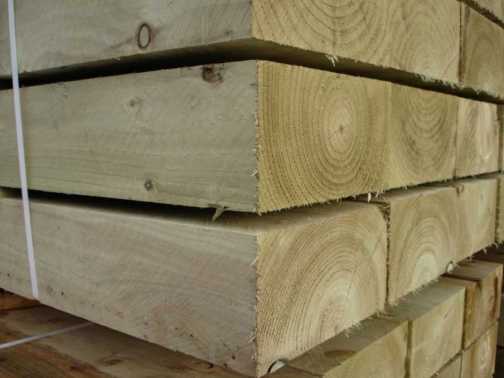
Our new eco friendly treated softwood railway sleepers have been treated with Tanalith, a much more environmentally friendly, 'greener' alternative to creosote, and is suitable for all kinds of landscaping. It is a water based preservative treatment that helps protect against decay and fungal and insect attack.
~ The railway sleepers are treated using vacuum & pressure impregnation.
~ When impregnated into the railway sleepers the chemical components become fixed within the wood structure and are leach resistant.
~ Suitable for use even in the most extreme environments such as marine applications.
~ Usually specified for general construction and ground contact timbers
~ Can be used in residential, commercial and industrial applications
~ Easily painted or stained
It is so far the most environmentally friendly form of pressure treatment available and has replaced the original CCA treatment. It does not contain arsenic or chromium and have a very low potential for human toxicity. An eco treatment will not leak out in the summer, and is particularly suitable for schools, play areas, children, animals, growing food and indoors, where creosote is unsuitable.
For more technical information please have a look at the Tanalith website or contact the technical guys at Tanalith.
https://www.arxadawoodprotection.com/eu/tanalith-family/
HOW LONG DOES IT LAST?
NO GUARANTEE!
Believe it or not, the treatment companies (and hence us!) offer no guarantee as to the treatment and the longevity of the railway sleepers. They argue that because:
a) timber is used and constructed in so many different applications and settings (above ground, under ground, in water etc...), and because
b) timber naturally splits and moves after treatment, which can expose untreated wood... and because
c) customers cut and drill into the treatment on the timber, leaving bare wood...
- they cannot guarantee or predict how long the railway sleepers will last and how long the treatment will be effective.
SITTING ON THE FENCE
In reality, like many companies, they are frightened about people making claims against them, and so they choose to offer no guarantee, rather than risk someone wanting the whole of their railway sleepers to be replaced after 10 years, if it starts to rot.
Recently we were told of an old traditional timber company that had once rashly offered a lifetime guarantee on their oak fencing. About a year ago an 80 year old lady came into their office brandishing a yellow discoloured receipt from 1959, and stating that several of her fence posts were now rotten! All credit to them, they went out and replaced them!
And the moral is... be careful what you promise!
CONCLUSION
Although we all know that pressure treated railway sleepers will last considerably longer than 2 days (!) we are unable to say or guarantee how long it will last. Sorry. It's all very unsatisfactory, but it's the way of the world !
3) UNTREATED RAILWAY SLEEPERS - THE FACTS
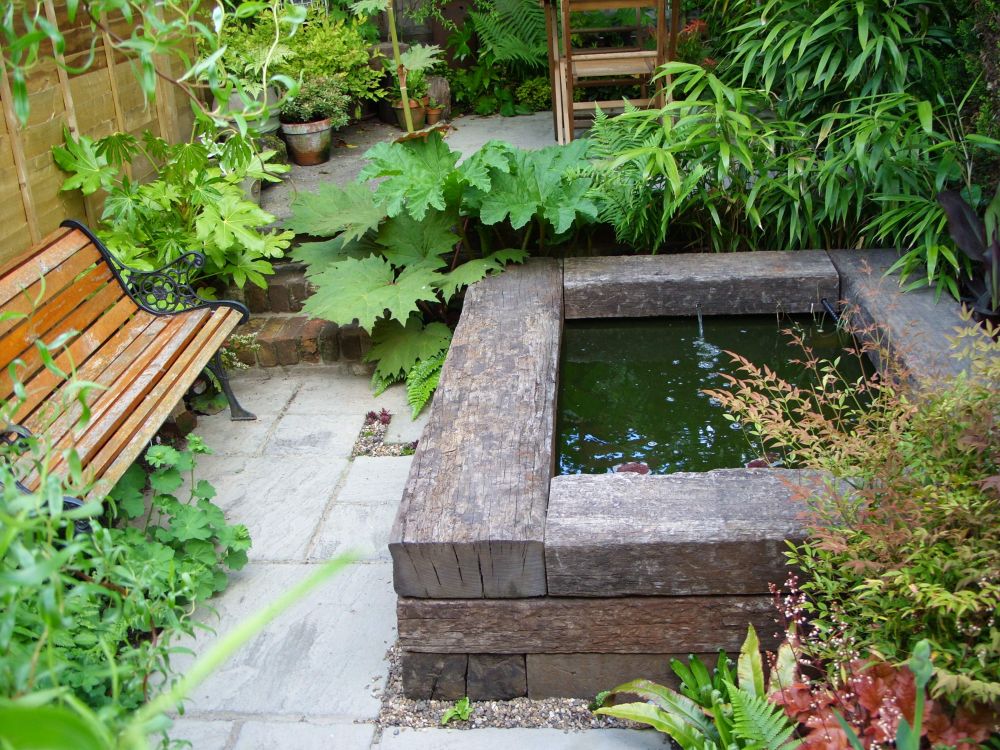 Dense, tight grained, untreated hardwood railway sleepers, are completely different to light, softwood railway sleepers which have to be treated with either creosote or pressure treatment to prevent them rotting and collapsing. Hardwood railway sleepers are generally much more durable, tighter grained and naturally longer lasting. Untreated railway sleepers are often popular with those wanting to keep clear of chemical treatments, or potential contamination, and eager to use something that is naturally longer lasting.
Dense, tight grained, untreated hardwood railway sleepers, are completely different to light, softwood railway sleepers which have to be treated with either creosote or pressure treatment to prevent them rotting and collapsing. Hardwood railway sleepers are generally much more durable, tighter grained and naturally longer lasting. Untreated railway sleepers are often popular with those wanting to keep clear of chemical treatments, or potential contamination, and eager to use something that is naturally longer lasting.
African Azobe railway sleepers, for example, are often used untreated by British Waterways under water, due to their natural preservative qualities. Jarra, Karri, Mora, and Greenheart are likewise placed untreated on the railway track by Network Rail, and are expected to last for up to 100 years.
People often ask: 'Do I need to treat untreated railway sleepers?'. Of course, you CAN apply a coat or two of wood preservative to them, and no doubt that would probably be beneficial, however it isn't essential, and most landscapers don't.
RailwaySleepers.com is registered by the environment agency
VOTE OF CONFIDENCE!
Please help us spread the word! If you've found our website helpful or inspiring please leave feedback or 'Like us' on Facebook, Instagram or Twitter. A simple way of letting people know "This is a really useful website!" Thanks



BUY ONLINE or
RING DIRECT
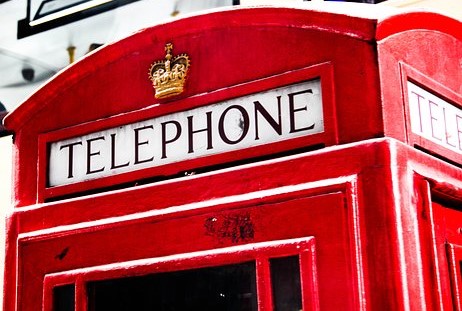
0115 9890445
enquiries@railwaysleepers.com
WHICH
RAILWAY SLEEPERS ARE
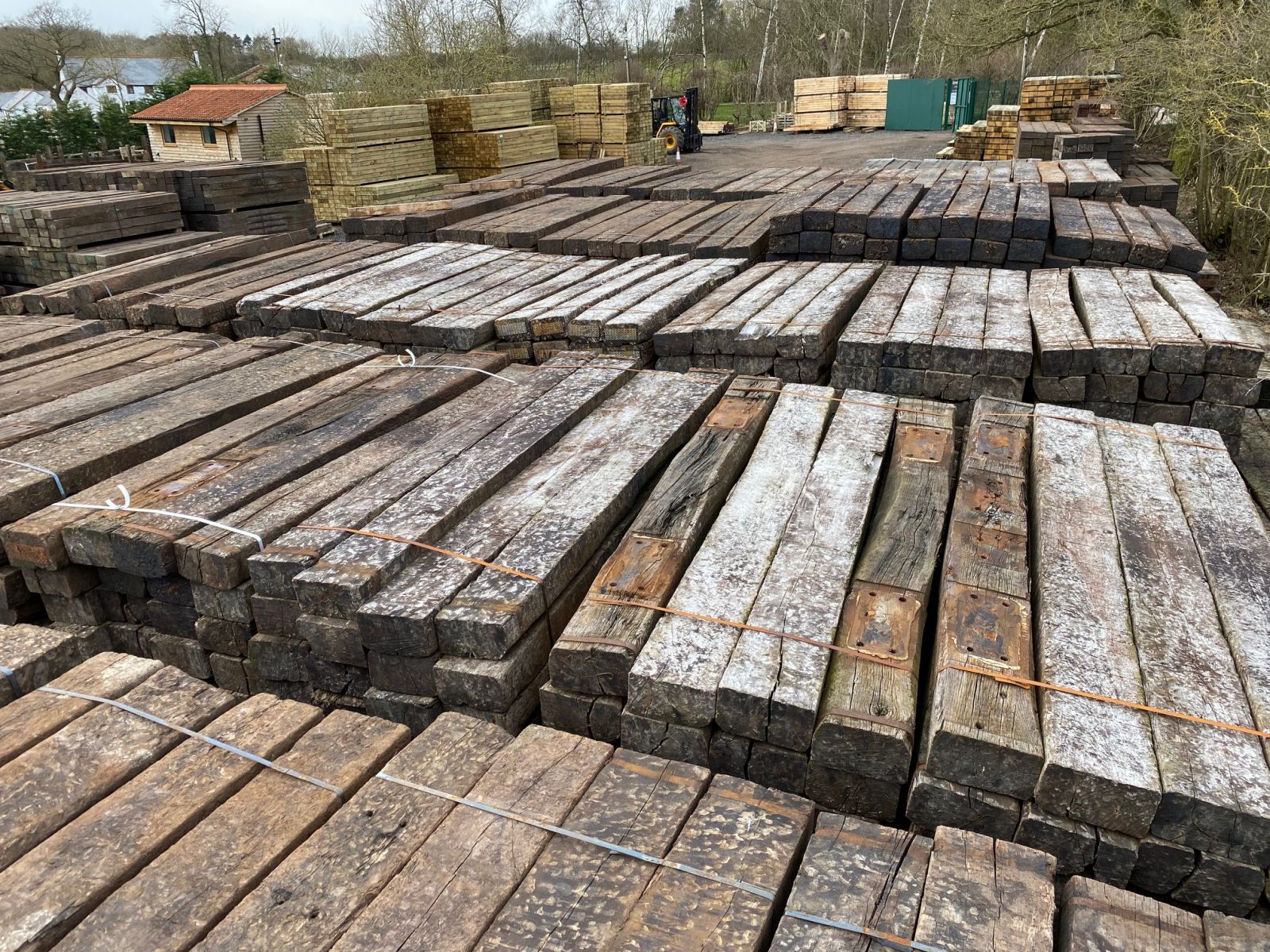
THE BEST?
JUST A CLICK CLICK CLICK AWAY
INSPIRATION?
NEED IDEAS?
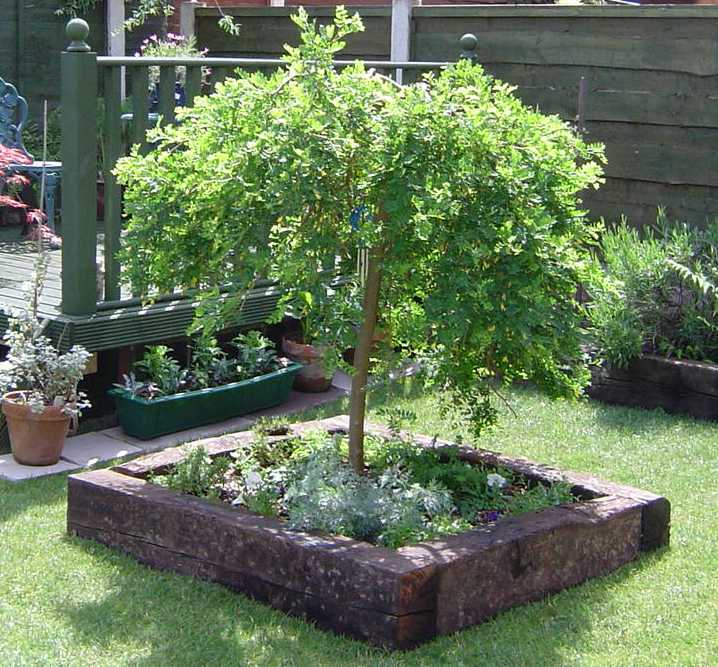
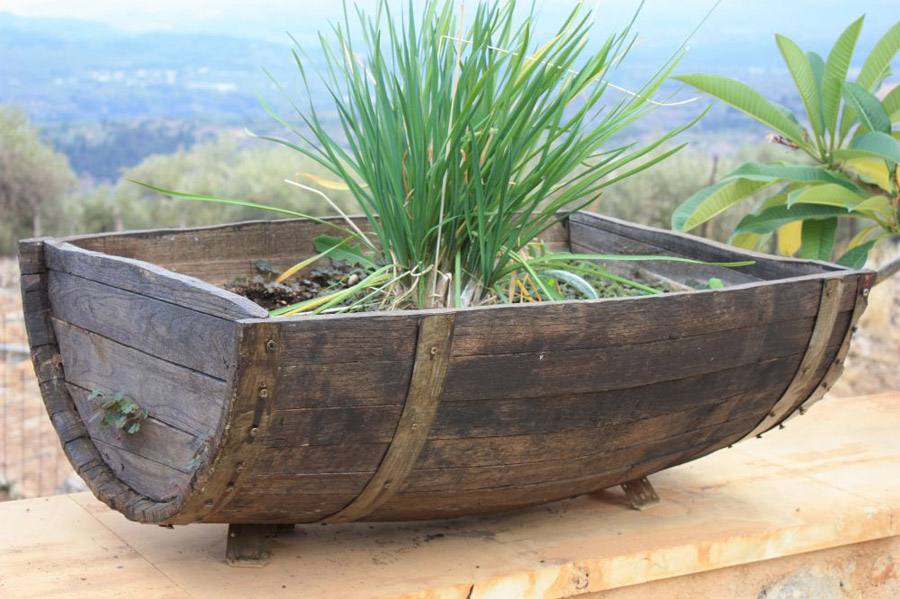

CLICK for the WORLD'S
LARGEST COLLECTION of
RAILWAY SLEEPER PROJECTS
SHARE
your project and creation
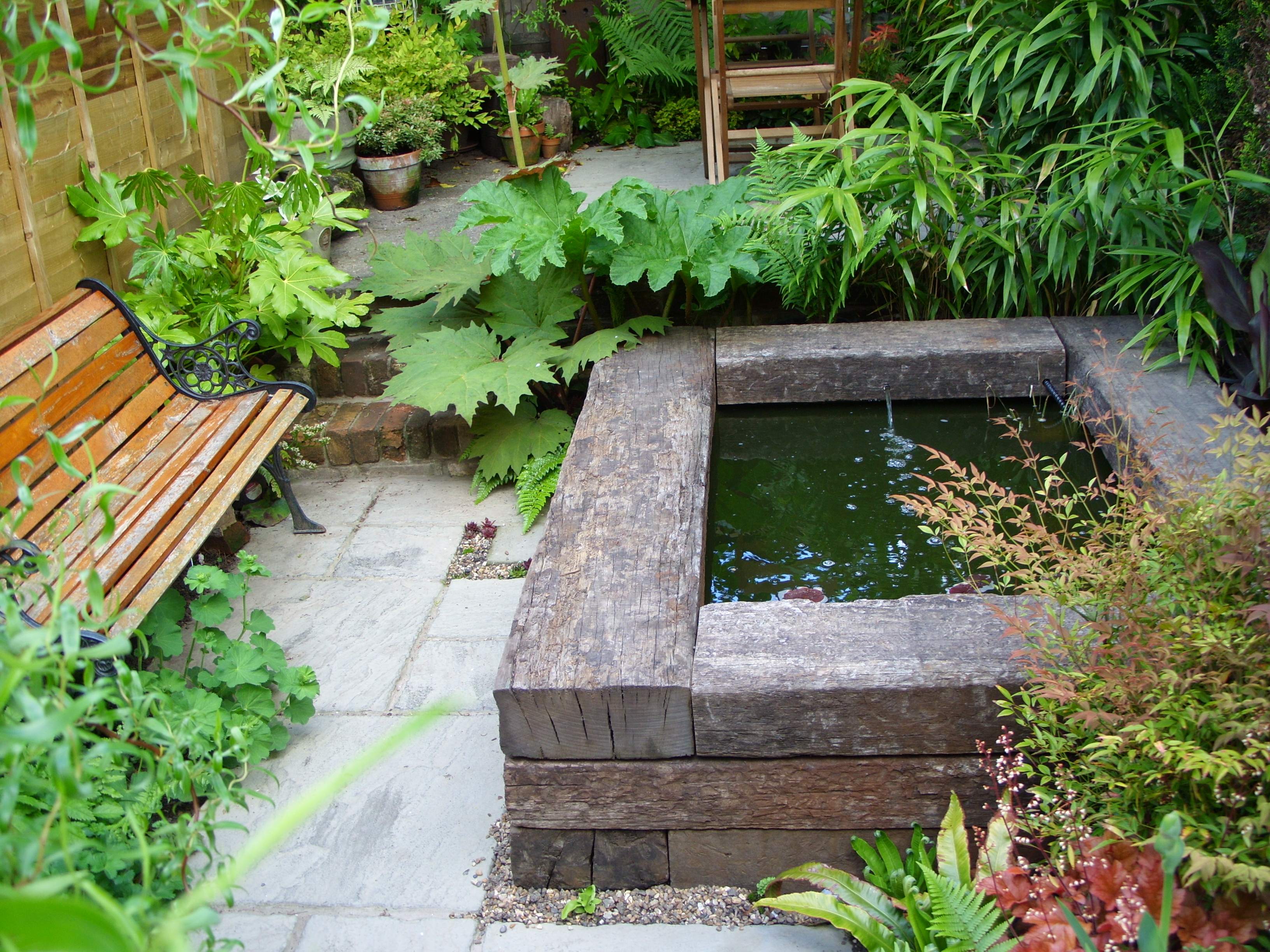
SEND your PHOTOS to
enquiries@railwaysleepers.com
or WhatsApp 07816 959310
CONFUSED?
Need some advice?

CONTACT US & we'll help you
work out what items you need.
0115 9890445


